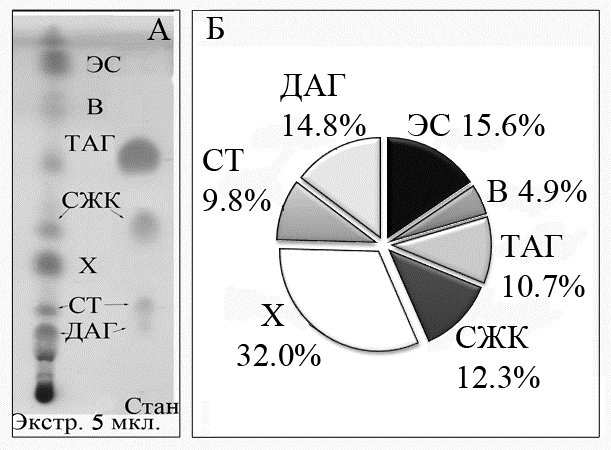LIPIDS, FATTY ACIDS AND PIGMENTS OF LEAVES DICTAMNUS CAUCASICUS FISCH. EX GROSSH. (RU-TACEAE)
UDC 573+57
Abstract
Plants of the genus Dictamnus are a source of chemical compounds with different biological activity – alkaloids, bitterness, furocoumarins, saponins, essential oils. In the present work, the qualitative and quantitative composition of components lipids, fatty acids, and pigments isolated from the leaves of Dictamnus caucasicus Fisch. ex Grossh. – is presented for the first time, also of interest for medicine and pharmacology. Plants were selected in the Samara region, on the territory of which D. caucasicus is currently under threat of extinction. Plant extracts were analyzed by high performance thin-layer and gas-liquid chromatography. Identification of polar lipids was carried out using specific reagents – anthrone reagent, molybdenum blue, Dragendorff’s reagent, 0.2% ninhydrin solution. Neutral lipids were identified using an mixture of standards – triacylglycerol (TAG), oleic acid (FFA), cholesterol (ST), diacyglycerol (DAG). It was shown that the main group of lipids contains carbohydrate fragments – glycolipids as structural components. Among phospholipids, a high content of phosphatidylglycerol was found, and in neutral lipids – free and esterified forms of sterols. Polyunsaturated linolenic acid (C18: 3n3) dominates in the composition of fatty acids, and chlorophyll a dominates in the pigment pool.
Downloads
Metrics
References
Mustafina A.N., Abramova L.M., Shigapov Z.Kh. Yasenets golostolbikovyy v Bashkortostane: biologiya, struktura populyatsiy, introduktsiya, okhrana. [Hollow-columnar ash in Bashkortostan: biology, population structure, introduc-tion, protection]. Ufa, 2014, pp. 20–22. (in Russ.).
Krasnaya kniga Samarskoy oblasti. T. 1. Redkiye vidy rasteniy i gribov. [Red Data Book of the Samara Region. Vol. 1. Rare species of plants and fungi]. Samara, 2017, p. 237. (in Russ.).
Gao X., Zhao P.-H., Hua J.-F. Chem. Biodiver., 2011, vol. 8, pp. 1234–1244. DOI: 10.1002/cbdv.201000132.
Klobukova-Alisova Ye.N. Dikorastushchiye poleznyye i vrednyye rasteniya Bashkirii. [Wild useful and harmful plants of Bashkiria]. Leningrad, 1960, vol. 1, 247 p. (in Russ.).
Du C.F., Yang X.X., Tu P.F. China J. Chin. Mater. Med., 2005, vol. 30, pp. 1663–1666.
Li J., Wang X., Zhang T., Wang C., Huang Z., Luo X., Deng Y. Asis. J. Pharm. Sci., 2015, vol. 10, pp. 81–98. DOI: 10.1016/j.ajps.2014.09.004.
van Hoogevest P., Wendel A. Eur. J. Lipid Sci. Technol., 2014, vol. 16, pp. 1088–1107. DOI: 10.1002/ejlt.201400219.
Chekman I.S., Gorchakova N.A., Rudenko A.V., Kurik M.V., Orlov A.A., Zagorodnyy M.I., Osinnyaya L.M. Zhur-nal NAMN Ukrainy, 2013, vol. 19, no. 3, pp. 286–296. (in Russ.).
Rozentsvet O.A., Fedoseyeva Ye.V., Terekhova V.A. Uspekhi sovremennoy biologii, 2019, vol. 139, no. 2, pp. 161–177. DOI: 10.1134/S0042132419020078. (in Russ.).
İnanç A.L. Akademik Gıda. 2011, vol. 9, pp. 26–32.
Lichtenthaller H.K. Methods in enzymol, 1987, vol. 148, pp. 350–382. DOI: 10.1016/0076-6879(87)48036-1.
Bligh E.G., Dyer W.J. Can. J. Biochem. Physiol., 1959, vol. 37, pp. 911–917.
Keyts M. Tekhnika lipidologii. [Technique of lipidology]. Moscow, 1975, 323 p. (in Russ.).
Vaskovsky V.E., Latyshev N.A. J. Chromatogr., 1975, vol. 115, pp. 246–249.
Rozentsvet O.A., Nesterov V.N., Bogdanova E.S. Phytochemistry, 2014, vol. 105, pp. 37–42. DOI: 10.1016/j.phytochem.2014.05.007.
Guschina I.A., Harwood J.L. Strategies for Lipid Analysis. Encyclopedia of Analytical Chemistry, John Wiley & Sons, 2014, pp. 1–17. DOI: 10.1002/9780470027318.a9920.
Li J., Wang X., Zhang T., Wang C., Huang Z., Luo X., Deng Y. Asian J. Pharm. Sci. IO, 2015, pp. 81–98. DOI: 10.1016/j.ajps.2014.09.004.
Wagner H., Hörhammer L., Wolff P. Biochem. Z, 1961, vol. 334, pp. 175–184.
Chapman K.D., Dyer J.M., Mullen R.T. J. Lipid Res., 2014, vol. 53, pp. 215–226. DOI: 10.1194/jlr.r021436.
Valitova Yu.N., Sulkarnayeva A.G., Minibayeva F.V. Biokhimiya, 2016, vol. 81, no. 8, pp. 1050–1068. (in Russ.).

Copyright (c) 2020 chemistry of plant raw material

This work is licensed under a Creative Commons Attribution 4.0 International License.

This work is licensed under a Creative Commons Attribution 4.0 International License.
The authors, which are published in this journal, agree to the following conditions:
1. Authors retain the copyright to the work and transfer to the journal the right of the first publication along with the work, at the same time licensing it under the terms of the Creative Commons Attribution License, which allows others to distribute this work with the obligatory indication of the authorship of this work and a link to the original publication in this journal .
2. The authors retain the right to enter into separate, additional contractual agreements for the non-exclusive distribution of the version of the work published by this journal (for example, to place it in the university depository or to publish it in a book), with reference to the original publication in this journal.
3. Authors are allowed to post their work on the Internet (for example, in a university repository or on their personal website) before and during the review process of this journal, as this may lead to a productive discussion, as well as more links to this published work.











